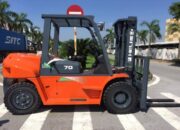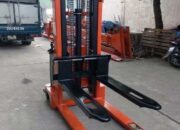Frequently Asked Questions about Common Issues with Toyota Forklifts
1. What are the causes and solutions for hydraulic oil leaks in Toyota forklifts?
– The causes can be worn or damaged hydraulic oil lines, loose or damaged seals and gaskets, stuck or faulty hydraulic control valves, or leaking lift cylinders.
– The solutions include checking and replacing damaged parts, regularly cleaning and maintaining the hydraulic system, and ensuring that the hydraulic oil is clean and at the required level.
2. What are the causes and solutions for difficult or failed engine starting in Toyota forklifts?
– Common causes include weak or faulty batteries, malfunctioning starter systems, fuel injection/fuel system issues, or fouled spark plugs.
– Solutions involve checking, charging, or replacing the battery; inspecting the starter system; cleaning or replacing fuel injection/fuel system components; and cleaning or replacing spark plugs if necessary.
3. How should you handle an overheating engine in a Toyota forklift?
– Causes may include low engine coolant levels, a faulty cooling fan, clogged coolant lines, or a leaking water pump.
– Solutions involve immediately stopping the operation of the forklift, checking the cooling system, adding coolant if needed, replacing the cooling fan or water pump if necessary, and cleaning and repairing any clogged coolant lines.
4. What are the causes and solutions for weak or loss of lifting power in Toyota forklifts?
– Causes can include decreased hydraulic pressure in the system, inefficient hydraulic pumps, or leaking or damaged lift cylinders.
– Solutions involve checking and addressing any factors that reduce hydraulic pressure, replacing the hydraulic pump if needed, and repairing or replacing faulty lift cylinders.
5. What should you do when the steering system of a Toyota forklift becomes stiff or too heavy?
Firstly, check the hydraulic fluid level for the steering system and top it up if it’s low. Then inspect the hydraulic lines and control valves for the steering system, replacing them if damaged. If the issue persists, it may be due to worn steering worm gears or a faulty steering shaft that needs replacement.
6. How should you handle ineffective braking in a Toyota forklift?
Firstly, check the brake fluid, replacing it if contaminated or low. Then inspect the friction surface of the brake discs, replacing them if worn. If the issue continues, check the brake cylinders, brake lines, and brake pump for any faults, repairing or replacing any damaged components.
7. What are the causes and solutions for non-functioning turn signals and lights in Toyota forklifts?
– Causes can include blown fuses, broken wires, burnt-out bulbs, or faulty light switches.
– Solutions involve checking and replacing blown fuses, repairing or replacing broken wires, installing new bulbs, and replacing faulty light switches if necessary.
8. How should you handle a malfunctioning battery charger in a Toyota forklift?
Firstly, check the battery itself; replace it if corroded or too old. Then inspect the wiring from the charger to the battery; replace any broken wires or shorts.
Next, check the charger; replace it if not functioning properly. Finally, adjust the charger settings to match the type of battery being used.
9. What should you do when there is hydraulic system leakage or loss of pressure in a Toyota forklift?
Firstly, check the hydraulic fluid level; top it up to the required level if low. Then inspect the entire hydraulic system to identify any leaks or loss of pressure.
Causes can include faulty hydraulic cylinders, hoses, valves, or seals/gaskets. Replace any damaged parts to restore pressure and ensure a tight seal in the system.
10. What are the causes and solutions for worn or damaged wheels on Toyota forklifts?
– The main causes are overloading, driving on rough terrain, sudden changes in direction leading to increased tire wear. Additionally, wheels can be damaged due to rough handling.
– Solutions involve ensuring proper loading during operation, driving cautiously on flat surfaces, and being careful when changing directions. Replace worn or damaged wheels with new ones.
11. How should you address transmission issues in a Toyota forklift?
Firstly, check the transmission fluid level; top it up if low. Then inspect the components of the transmission system such as the clutch, drive shaft, couplings, and belts; replace any damaged parts if necessary.
Finally, check the gearbox and gearbox oil pump; replace them if faulty. Regularly maintain and clean the entire transmission system.
12. What are the causes and solutions for a stuck parking brake in a Toyota forklift?
– Common causes include a jammed or broken parking brake cable, deteriorated rubber grommets causing cable sticking, or a stuck or rusted brake drum.
– Solutions involve removing and cleaning the parking brake cable, replacing it if broken, replacing deteriorated rubber grommets, lubricating the brake drum with grease if necessary, and replacing heavily rusted brake drums.
13. How should you handle a malfunctioning stability control system in a Toyota forklift?
Firstly, check the hydraulic fluid level for the stability control system; top it up to the required level if low. Then inspect the hydraulic control valve and hydraulic cylinders to ensure there are no leaks. Replace valves or cylinders as needed.







